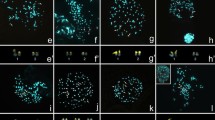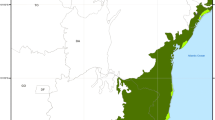Abstract
The genus Microtus consists of 65 extant species, making it one of the rodentia genera with the highest number of species. The extreme karyotype diversification in Microtus has made them an ideal species group for comparative cytogenetics and cytotaxonomy. Conventional comparative cytogenetic studies in Microtus have been based mainly on chromosomal banding patterns; the number of Microtus species examined by molecular cytogenetics—cross-species chromosome painting—is limited. In this study, we used whole chromosome painting probes of the field vole Microtus agrestis to detect regions of homology in the karyotypes of eight Microtus species. For almost all investigated species, species-specific associations of conserved chromosomal segments were revealed. Analysis of data obtained here and previously published data allowed us to propose that the ancestral Microtus species had a 2n = 54 karyotype, including two associations of field vole chromosomal segments (MAG 1/17 and 2/8). Further mapping of the chromosome rearrangements onto a molecular phylogenetic tree allows the reconstruction of a karyotype evolution pathway in the Microtus genus.







Similar content being viewed by others
Abbreviations
- 2n :
-
Diploid number of chromosomes
- AMiK:
-
Ancestral karyotype of genus Microtus
- ETA:
-
Ellobius talpinus
- FISH:
-
Fluorescent in situ hybridization
- GTG banding:
-
G-banding by trypsin using Giemsa
- MARA:
-
M. arvalis “arvalis”
- MAG:
-
M. agrestis
- MDA:
-
M. daghestanicus
- MDO:
-
M. dogramacii
- MGR:
-
M. gregalis
- MGUG:
-
M. guentheri guentheri
- MMA:
-
M. maximowiczii
- MOE:
-
M. oeconomus
- MRO:
-
M. rossiaemeridionalis
- MSO:
-
M. socialis
- MY:
-
Million years
- NFa:
-
Fundamental autosomal number
References
Agadjanyan A, Yacenko B (1984) Phylogenetic relationships of voles from North Eurasia. In: The problem of variability and phylogeny of mammals. MSU, Moscow, pp 135–190 (Russian)
Burgos M, Jimenez R, Dias de la Guardia К (1988a) XY females in Microtus cabrerae (Rodentia, Microtidae): a case of possibly Y-linked sex reversal. Cytogenet Cell Genet 49:275–277
Burgos M, Jimenez R, Olmos DM (1988b) Heterogeneous heteroсhromatin and size variations in the sex chromosomes of Microtus cabrerae. Cytogenet Cell Genet 47:75–79
Chaline J, Brunet-Lecomte P, Motuire S et al (1999) Anatomy of the arvicoline radiation (Rodentia): paleogeographical, paleoecological history and evolutionary data. Ann Zool Fennici 36:239–267
Conroy CJ, Cook JA (1999) MtDNA evidence for repeated pulses of speciation within arvicoline and murid rodents. J Mamm Evol 6:221–245
Dobigny G, Ducroz JF, Robinson TJ, Volobouev V (2004) Cytogenetics and cladistics. Syst Biol 53(3):470–484
Galewski T, Tilak M, Sanchez S et al (2006) The evolutionary radiation of Arvicolinae rodents (voles and lemmings): relative contribution of nuclear and mitochondrial DNA phylogenies. BMC Evol Biol 6:80
Gamperl T (1982) Chromosomal evolution in the genus Clethrionomys. Genetica 57:193–197
Golenishchev FN, Sablina OV (1991) On taxonomy of Microtus (Blanfordimys) afghanus. Zoologicheskii Zhurnal 70:98–110 (Russian)
Golenishchev FN, Malikov VG (2006) The “developmental conduit” of the tribe Microtini (Rodentia, Arvicolinae): systematic and evolutionary aspects. Russian J Theriol 5(1):19–26
Graphodatsky AS, Yang F, O’Brien PC et al (2000) A comparative chromosome map of the Arctic fox, red fox and dog defined by chromosome painting and high resolution G-banding. Chromosome Res 8:253–263
Gromov IM, Polyakov IY (1992) Fauna of the USSR 3. Voles (Microtinae). Brill, Leiden
Jaarola M, Martinkova N, Günduüz I et al (2004) Molecular phylogeny of the speciose vole genus Microtus (Arvicolinae, Rodentia) inferred from mitochondrial DNA sequences. Mol Phylogenet Evol 33:647–663
Kryštufek B, Griffiths HI, Vohralik V (1996) The status and use of Terricola Fatio, 1867 in taxonomy of Palearctic pine voles (Pitymys) (Rodentia, Arvicolinae). Bull Inst R Sci Nat Belg Biol 66:237–240
Li T, Wang J, Su W et al (2006) Chromosomal mechanisms underlying the karyotype evolution of the oriental voles (Muridae, Eothenomys). Cytogenet Genome Res 114:50–55
Matthey R (1957) Cytologie comparee systematique et phylogenie des Microtinae (Rodentia: Muridae). Rev Suisse Zool 64:39–71
Matthey R (1973) The chromosome formulae of eutherian mammals. In: Chiarelli AB, Capanna E (eds) Cytotaxonomy and vertebrate evolution. Academic, London, pp 531–616
Mayorov VI, Adkison LR, Vorobyeva NV et al (1996) Organization and chromosomal localization of a B1-like containing repeat of Microtus subarvalis. Mamm Genome 7:593–597
Mazurok NA, Rubtsova NV, Isaenko AA et al (2001) Comparative chromosome and mitochondrial DNA analyses and phylogenetic relationships within common voles (Microtus, Arvicolidae). Chromosome Res 9:107–120
Meyer MN, Radjabli SI, Bulatova NSh et al (1985) Karyological peculiarities and probable relations of common voles of the group “arvalis” (Rodentia, Cricetidae, Microtus). Zool Zh 64:417–428 (in Russian with English summary)
Meyer MN, Golenishchev FN, Radjabli SI et al (1996) Voles (subgenus Microtus Schrank) of Russia and adjacent territories. Russ Acad Sci, Proc Zool Inst 232:3–320, Russian
Modi WS (1987a) Phylogenetic analyses of chromosomal banding patterns among the Neartic Arvicolidae (Mammalia, Rodentia). Syst Zool 36:109–136
Modi WS (1987b) C-banding analysis and the evolution heterochromatin among arvicolid rodents. J Mamm 68:704–714
Modi WS (1993) Comparative analysis of heterochromatin in Microtus: sequence heterogeneity and localized expansion and contraction of satellite DNA arrays. Cytogenet Cell Genet 62:142–148
Modi WS, Serdyukova NA, Vorobieva NV, Graphodatsky AS (2003) Chromosomal localization of six repeat DNA sequences among species of Microtus (Rodentia). Chromosome Res 11:705–713
Musser GG, Carleton MD (2005) Order Rodentia. In: Wilson DE, Reeder DM (eds) Mammal species of the world: a taxonomic and geographic reference. Johns Hopkins University Press, Baltimore, pp 989–1019
Orlov VN, Malygin VM (1969) Two forms of 46-chromosome common vole Microtus arvalis Pallas. Mammals (evolution, karyology, systematics, faunistics). Novosibirsk, pp 143–144 (Russian)
Repenning CA, Feifar O, Heinrich WD (1990) Arvicolid rodent biochronology of the northern hemisphere. In: Feifar O, Heinrich WD (eds) International symposium on the evolution, phylogeny and biostratigraphy of arvicolids (Rodentia, Mammalia). Pfiel-Verlag, Munich, pp 385–418
Romanenko SA, Sitnikova NA, Serdukova NA et al (2007) Chromosomal evolution of Arvicolinae (Cricetidae, Rodentia). II. The genome homology of two mole voles (genus Ellobius), the field vole and golden hamster revealed by comparative chromosome painting. Chromosome Res 15:891–897
Sablina OV, Radjabli SI, Graphodatsky AS (2006) Selected karyotypes. In: O’Brien SJ, Nash WG, Menninger JC (eds) Atlas of mammalian karyotypes. Wiley, Chichester, pp 237–239
Schibler L, Vaiman D, Oustry A, Giraud-Delville C, Cribiu EP (1998) Comparative gene mapping: a fine-scale survey of chromosome rearrangements between ruminants and humans. Genome Res 8(9):901–915
Seabright M (1971) A rapid banding technique for human chromosomes. Lancet 2:971–972
Sitnikova NA, Romanenko SA, O’Brien PCM et al (2007) Chromosomal evolution of Arvicolinae (Cricetidae, Rodentia). I. The genome homology of tundra vole, field vole, mouse and golden hamster revealed by comparative chromosome painting. Chromosome Res 15:447–456
Sperling K, Kalscheuer V, Kottusch-Geisler V et al (1990) Genetic activity of constitutive heterochromatin in mammals. Chrom Today 10:83–89
Trifonov VA, Stanyon R, Nesterenko AI et al (2008) Multidirectional cross-species painting illuminates the history of karyotypic evolution in Perissodactyla. Chromosome Res 16:89–107
Volobouev VT, Gallardo MH, Graphodatsky AS (2006) Rodents cytogenetics. In: O’Brien SJ, Nash WG, Menninger JC (eds) Atlas of mammalian karyotypes. Wiley, Chichester, pp 173–176
Yang F, O’Brien PC, Milne BS et al (1999) A complete comparative chromosome map for the dog, red fox, and human and its integration with canine genetic maps. Genomics 62:189–202
Zheng S-H, Zhang Z-Q (2000) Late Miocene–Early Pleistocene micromammals from Wenwanggou of Lingtai, Gansu, China. Vertebrata Pal Asiatica 38:58–71
Acknowledgments
This study was funded in part by research grants from MCB and SB RAS Programs, Russian Fund for Basic Research: 09-04-00851-а (A.S.G.), and Russian Federation President’s grant: MK-2241.2009.4 (S.A.R). The Cambridge Resource Centre for Comparative Genomics was supported by a grant from the Wellcome Trust (MAFS).
Author information
Authors and Affiliations
Corresponding author
Additional information
Responsible Editor: Yoichi Matsuda.
Rights and permissions
About this article
Cite this article
Lemskaya, N.A., Romanenko, S.A., Golenishchev, F.N. et al. Chromosomal evolution of Arvicolinae (Cricetidae, Rodentia). III. Karyotype relationships of ten Microtus species. Chromosome Res 18, 459–471 (2010). https://doi.org/10.1007/s10577-010-9124-0
Received:
Revised:
Accepted:
Published:
Issue Date:
DOI: https://doi.org/10.1007/s10577-010-9124-0




